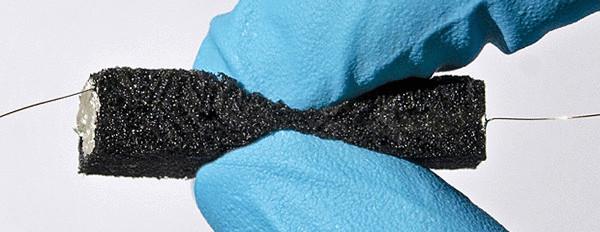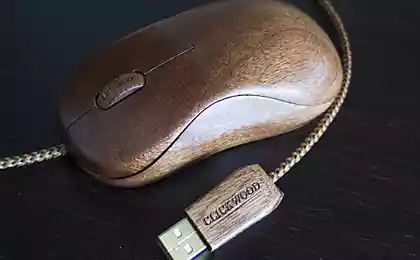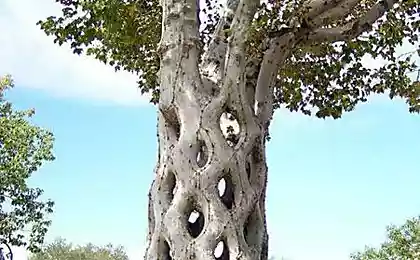393
Soft, battery made of wood
Cellulose nanofibers obtained from wood pulp turns out to be quite a useful thing. We have previously described the creation of biodegradable computer chips. Now researchers from Sweden and the USA used this material to produce soft batteries, which are more shock resistant than their conventional rigid counterparts.

Using cellulose nanofibers from wood fibers, a team from the Royal Institute of technology and Stanford University have produced a soft material for batteries that can withstand heavy external impact.
"You can create incredible materials from trees and pulp," says Max Hamedi (Max Hamedi), a researcher from the Royal Institute of technology and Harvard University. "One of the advantages of wood-based aerogel is that it can be used for three-dimensional structures".
"There is a limit value of how thin the battery can be, but it becomes less important in 3D" tells of Hamedi. "We are no longer limited to two dimensions. We can create in three dimensions, which allows us to put more electronics in less space".
3D structure allows you to store much more energy in a smaller space than is possible with conventional batteries.
"Three-dimensional, porous materials was seen as an obstacle to the creation of the electrodes. But we proved that it is not a problem. In fact, this type of structure and material architecture to allow flexibility and freedom in design batteries".
Cellulose nanofibers, also known as cellulose nanofibrils (CNF). The creation process begins with the destruction of the wood fibers, which makes it about a million times thinner. Cellulose nanofibers dissolve, freeze and then produce the cold-dried so that all moisture evaporates, bypassing the liquid state. The material then goes through a process in which molecules stabiliziruemost so that the material is not destroyed.
"The result is a material that is both durable, light and soft," says Hamedi. "The material looks like foam in the mattress, although it is a little harder, lighter and more porous. You can touch him without risking hurt."
The finished aerogel can then be equipped with electronic properties. "We use a very exact method, is approximately at the atomic level by adding inks that conduct electricity in the aerogel. Thus, it is possible to cover the entire surface from the inside."
From the point of view of surface area of Hamadi compares the material with a pair of human lungs, which, if deployed, could cover a whole football field. "The same way one cubic decimeter of battery material will have a working surface that extends more than half a football field," he explains.
"You can push him as much as you want. While flexible, stretchable electronics already existed, the anti-shock feature is an innovation".
The study was conducted in the Science center Wallenberg wood Royal Institute of technology. published
P. S. And remember, only by changing their consumption — together we change the world! ©
Source: www.ekopower.ru/?p=3571

Using cellulose nanofibers from wood fibers, a team from the Royal Institute of technology and Stanford University have produced a soft material for batteries that can withstand heavy external impact.
"You can create incredible materials from trees and pulp," says Max Hamedi (Max Hamedi), a researcher from the Royal Institute of technology and Harvard University. "One of the advantages of wood-based aerogel is that it can be used for three-dimensional structures".
"There is a limit value of how thin the battery can be, but it becomes less important in 3D" tells of Hamedi. "We are no longer limited to two dimensions. We can create in three dimensions, which allows us to put more electronics in less space".
3D structure allows you to store much more energy in a smaller space than is possible with conventional batteries.
"Three-dimensional, porous materials was seen as an obstacle to the creation of the electrodes. But we proved that it is not a problem. In fact, this type of structure and material architecture to allow flexibility and freedom in design batteries".
Cellulose nanofibers, also known as cellulose nanofibrils (CNF). The creation process begins with the destruction of the wood fibers, which makes it about a million times thinner. Cellulose nanofibers dissolve, freeze and then produce the cold-dried so that all moisture evaporates, bypassing the liquid state. The material then goes through a process in which molecules stabiliziruemost so that the material is not destroyed.
"The result is a material that is both durable, light and soft," says Hamedi. "The material looks like foam in the mattress, although it is a little harder, lighter and more porous. You can touch him without risking hurt."
The finished aerogel can then be equipped with electronic properties. "We use a very exact method, is approximately at the atomic level by adding inks that conduct electricity in the aerogel. Thus, it is possible to cover the entire surface from the inside."
From the point of view of surface area of Hamadi compares the material with a pair of human lungs, which, if deployed, could cover a whole football field. "The same way one cubic decimeter of battery material will have a working surface that extends more than half a football field," he explains.
"You can push him as much as you want. While flexible, stretchable electronics already existed, the anti-shock feature is an innovation".
The study was conducted in the Science center Wallenberg wood Royal Institute of technology. published
P. S. And remember, only by changing their consumption — together we change the world! ©
Source: www.ekopower.ru/?p=3571
























